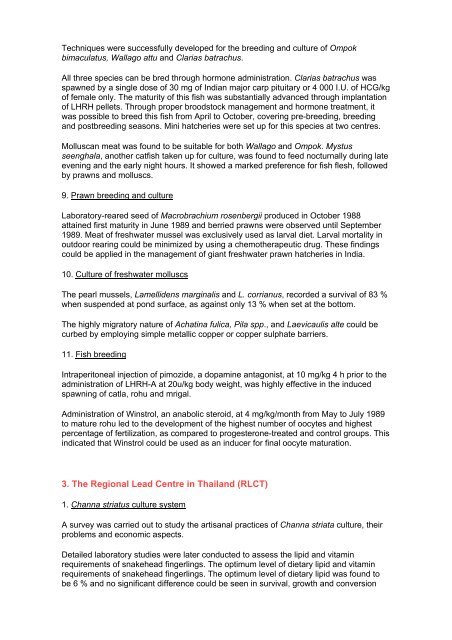Excerpt from the Terminal Report on the NACA Project1 - Library
Excerpt from the Terminal Report on the NACA Project1 - Library
Excerpt from the Terminal Report on the NACA Project1 - Library
You also want an ePaper? Increase the reach of your titles
YUMPU automatically turns print PDFs into web optimized ePapers that Google loves.
Techniques were successfully developed for <str<strong>on</strong>g>the</str<strong>on</strong>g> breeding and culture of Ompok<br />
bimaculatus, Wallago attu and Clarias batrachus.<br />
All three species can be bred through horm<strong>on</strong>e administrati<strong>on</strong>. Clarias batrachus was<br />
spawned by a single dose of 30 mg of Indian major carp pituitary or 4 000 I.U. of HCG/kg<br />
of female <strong>on</strong>ly. The maturity of this fish was substantially advanced through implantati<strong>on</strong><br />
of LHRH pellets. Through proper broodstock management and horm<strong>on</strong>e treatment, it<br />
was possible to breed this fish <str<strong>on</strong>g>from</str<strong>on</strong>g> April to October, covering pre-breeding, breeding<br />
and postbreeding seas<strong>on</strong>s. Mini hatcheries were set up for this species at two centres.<br />
Molluscan meat was found to be suitable for both Wallago and Ompok. Mystus<br />
seenghala, ano<str<strong>on</strong>g>the</str<strong>on</strong>g>r catfish taken up for culture, was found to feed nocturnally during late<br />
evening and <str<strong>on</strong>g>the</str<strong>on</strong>g> early night hours. It showed a marked preference for fish flesh, followed<br />
by prawns and molluscs.<br />
9. Prawn breeding and culture<br />
Laboratory-reared seed of Macrobrachium rosenbergii produced in October 1988<br />
attained first maturity in June 1989 and berried prawns were observed until September<br />
1989. Meat of freshwater mussel was exclusively used as larval diet. Larval mortality in<br />
outdoor rearing could be minimized by using a chemo<str<strong>on</strong>g>the</str<strong>on</strong>g>rapeutic drug. These findings<br />
could be applied in <str<strong>on</strong>g>the</str<strong>on</strong>g> management of giant freshwater prawn hatcheries in India.<br />
10. Culture of freshwater molluscs<br />
The pearl mussels, Lamellidens marginalis and L. corrianus, recorded a survival of 83 %<br />
when suspended at p<strong>on</strong>d surface, as against <strong>on</strong>ly 13 % when set at <str<strong>on</strong>g>the</str<strong>on</strong>g> bottom.<br />
The highly migratory nature of Achatina fulica, Pila spp., and Laevicaulis alte could be<br />
curbed by employing simple metallic copper or copper sulphate barriers.<br />
11. Fish breeding<br />
Intraperit<strong>on</strong>eal injecti<strong>on</strong> of pimozide, a dopamine antag<strong>on</strong>ist, at 10 mg/kg 4 h prior to <str<strong>on</strong>g>the</str<strong>on</strong>g><br />
administrati<strong>on</strong> of LHRH-A at 20u/kg body weight, was highly effective in <str<strong>on</strong>g>the</str<strong>on</strong>g> induced<br />
spawning of catla, rohu and mrigal.<br />
Administrati<strong>on</strong> of Winstrol, an anabolic steroid, at 4 mg/kg/m<strong>on</strong>th <str<strong>on</strong>g>from</str<strong>on</strong>g> May to July 1989<br />
to mature rohu led to <str<strong>on</strong>g>the</str<strong>on</strong>g> development of <str<strong>on</strong>g>the</str<strong>on</strong>g> highest number of oocytes and highest<br />
percentage of fertilizati<strong>on</strong>, as compared to progester<strong>on</strong>e-treated and c<strong>on</strong>trol groups. This<br />
indicated that Winstrol could be used as an inducer for final oocyte maturati<strong>on</strong>.<br />
3. The Regi<strong>on</strong>al Lead Centre in Thailand (RLCT)<br />
1. Channa striatus culture system<br />
A survey was carried out to study <str<strong>on</strong>g>the</str<strong>on</strong>g> artisanal practices of Channa striata culture, <str<strong>on</strong>g>the</str<strong>on</strong>g>ir<br />
problems and ec<strong>on</strong>omic aspects.<br />
Detailed laboratory studies were later c<strong>on</strong>ducted to assess <str<strong>on</strong>g>the</str<strong>on</strong>g> lipid and vitamin<br />
requirements of snakehead fingerlings. The optimum level of dietary lipid and vitamin<br />
requirements of snakehead fingerlings. The optimum level of dietary lipid was found to<br />
be 6 % and no significant difference could be seen in survival, growth and c<strong>on</strong>versi<strong>on</strong>

















